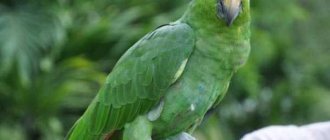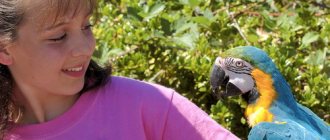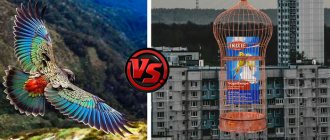The genus Aratinga includes more than 24 subspecies, but the solar Aratinga is considered one of the most attractive. This bright bird is very popular among bird lovers. She is valued not only for her appearance (rich colors), but also for her intelligence and interesting behavior.
By Bernard DUPONT
Appearance
Adult parrots weigh on average 100 grams and reach a length of 25-33 centimeters. Depending on the type of bird, the color can vary from sunny yellow to emerald green. As a rule, in addition to the main color, the aratinga has feathers of red, blue, yellow and green shades. The eyes of parrots are framed by a border that outlines shiny dark pupils. The tail consists of wedge-shaped feathers of different lengths: the longest ones are located below, and the shortest ones are located on top. In relation to the head, the beak of birds is large and very wide.
Externally, it is almost impossible to distinguish a male from a female. Individuals of the same species have absolutely the same colors and sizes. Determining the sex of the aratinga is a task for an ornithologist or veterinarian. If you want to breed these beautiful birds at home, but are not sure that the individuals you like are of different sexes, check this question with the clinic.
Habitat
The aratinga parrot prefers to live in multi-tiered forests in which a sufficient amount of plant food grows. Today, all species of this bright representative of birds can be found in South and Central America. Under natural conditions, birds live no more than 15 years. Due to their small size and extremely noticeable coloring, the aratinga is subject to attacks from various predators. In recent decades, these birds have also been killed by people. This is due to the love of “flying flowers” for grain crops, especially corn. The death of individuals is also caused by diseases, natural disasters and low yields.
At home, bright parrots can live up to 30 years. The most common pet, inseparable from its owner, is the sunny aratinga. With proper care, proper nutrition and the ability to fly, they feel comfortable even in small apartments. Keeping “flying flowers” is not difficult, but they need to be given a lot of attention. If it is deficient, birds may become demanding and produce loud, insistent trills.
Lifestyle in nature
The natural habitat of the solar aratinga is Guyana, Venezuela, Brazil. These birds of paradise live in flocks and inhabit mainly forests and palm groves. They feed on vegetation, cereals, and fruits. They approach the choice of couples very responsibly, become attached to each other, creating a real family. Both sexes show care for the future chicks; the male, in addition to his direct responsibilities of obtaining food and protecting the family, also helps the female to hatch the eggs. Incubation of the clutch lasts more than three weeks. And the children hatched from the eggs leave the parental nest-house already at 7-8 weeks, by which time the chicks have feathers and can more or less fly.
Lifestyle and character
In the forests of South and Central America, the Aratinga parrot does not live alone. This bird prefers to gather with its relatives in numerous flocks and obtain food through joint efforts. All individuals are active, so they spend most of their lives in motion. Pair formation occurs directly during the mating season.
Because of their bright plumage, aratingas are forced to hide from dangers of various kinds in the dense foliage of trees. Birds also have to hide from farmers, enraged by attacks on their crops, in the forests. At home, “flying flowers” are more communicative. The abundance of food and solitary life force them to change their behavior and treat people as members of their pack. As a rule, the Aratinga parrot shows strong affection for the person who spends more time talking with it and feeding it.
Spreading
The homeland of Arating parrots is America. They can be found in the deciduous forests of Brazil (aratinga yandaya and golden), mainly in highlands, on the edges of damp forests, in parks and savannas of Peru, Bolivia and Argentina (golden-fronted).
In the past, they were found everywhere throughout the entire territory of these countries, but the spread of predators, the transfer of their habitat from familiar lands to unfamiliar places, which occurred under human influence, had a significant negative impact on the number.
Farmers who grow vegetables and fruits near the area favored by the Yandaya aratinga parrots destroy them by the dozens, quite reasonably fearing for their harvest.
Nutrition
In natural conditions, bright parrots feed on fresh leaves, greens and fruits. They do not disdain grain that has ripened in the farmers’ fields. In captivity, it is recommended to add nuts, egg mixture, white bread and mineral supplements to their regular food. This diet allows you to maintain the healthy appearance of the birds and the brightness of their color. Water is also extremely important for them.
The Aratinga parrot does not accept animal food, so you should not offer it such mixtures. If a curious bird wants to try food from the human table, it is better to stop such attempts. It is not advisable for these parrots to consume salt, chocolate, avocados, sugar, cold and hot foods.
Price
The average price is 15-25 thousand rubles. It depends on age and color, complaisance and ability to talk, readiness to communicate with people. Sunny and black, nandayas are more expensive than simple green ones.
Yandaya parrots are the most famous birds of their kind. They adapt well to any living conditions, learn quickly, become attached to their owner, and can speak and even recite poetry. In the wild they live for about 15 years, but in captivity they can live up to 25-30 years. Unpretentious to keeping at home.
Previous
All types of Venezuelan Amazon and its features
Next
All types of New Zealand parrot Kea and its features
Reproduction
To breed offspring, birds that have reached 4 years of age build nests in tree hollows, gnawing wood with strong beaks. Soft bedding made from dried blades of grass, leaves and small twigs is placed in the voluminous niches of the aratinga. Usually the clutch consists of 3, less often five eggs. Birds lay 1-2 eggs at intervals of several days. Females spend 24 to 28 days incubating. The male sunaringa, as well as other species, acts as the guard of the nest and the main breadwinner. He brings the young mother and babies the most delicious food he can find in the forest. In 2 months, the young generation grows stronger and gains enough strength to begin an independent life outside the parental nest.
Aratinga breeding is also possible in captivity. To do this, the created pair is transplanted into a separate enclosure. Birds will feel most comfortable in a cage with a height of just over 2 meters, a depth of a meter and a width of 50 centimeters. The bird lays its clutch at the end of the nest and protects it until the chicks hatch. As a rule, during the nesting season, the male Arathea parrot becomes more sociable, so he more often attracts the attention of the owner by screaming. His behavior returns to normal as soon as the tiny parrots are born. The male is completely absorbed in caring for children, to which he devotes most of his time.
Sunny Aratinga - a parrot with high intelligence
This species is considered the most popular among parrot breeders. It got its name because of its unusually juicy, rich yellow color. The head and most of the bird's body are decorated with sunny yellow feathers. The bird's eyes are outlined by a thin pale gray rim, around which two orange spots diverge. On the lower part of the wings, the sun aratinga parrot has many greenish feathers, and on the tail there are a few blue ones. The bird acquires permanent color only at the age of 2 years. In youth the plumage may be green. The length from the head to the tip of the bird's tail is 17 - 30 centimeters.
In addition to the fact that parrots of this species are incredibly cheerful and active, they are easy to train. The Sunny Aratinga can remember several phrases, dozens of words and tricks. They are easy to train and extremely interesting. Since this species does not belong to the “talking” parrots, you should not count on the bird’s large vocabulary. “Flying flowers” have a special love for entertainment. They can make either a person or another animal a playmate. Birds do not conflict, so they get along well with a wide variety of bird species.
Criterias of choice
It is better to purchase a feathered friend from a specialized breeder or nursery. This way you will avoid buying an old, wild, sick bird. When choosing a parrot, consider the following factors:
Age
All tail and tail feathers should already be in place. Do not believe it if an unfeathered individual is passed off as a chick. Perhaps she is sick or has lost her feathers from old age. It is better to purchase Aratinga for successful taming at the age of 3-6 months.
Signs of the disease
Examine the parrot. A healthy bird has a neat appearance. The feathers near the cloaca should be clean and the skin should not be inflamed. The pet's gaze is clear. All toes and claws are present on the feet and there are no spots or scales.
Sunny Aratinga - my impressions after a year of life.
Reaction to a person
The most sociable, affectionate pets are obtained from chicks that are hand-fed or periodically taken out of the nest to play with humans. When you approach, the bird should not rush around the cage, scream or show aggression. A tamed parrot will remain in place or move away slightly, remaining calm.
Aratinga Yandaya(Endaya)
This variety is easily recognized by its greenish color. Most of the parrot's plumage is light green, with only small areas under the tail and on the head containing other colors. Around the eyes there are beige-white feathers that seem to frame almost black pupils. The beak is pink-beige. There may be orange spots on the surface of the head and wings. And the under-tail space of the aratinga yandaya is often decorated with several yellow feathers.
In general, the character of this species is not much different from the sun parrot. Its only feature is the strong attachment of individuals to each other. The male and female, once united in a pair, remain in it until their death. Most of the time, individuals are together and are separated only when necessary.
Conditions
Poultry are terribly clean, the cage in which they live, as well as all surfaces accessible to them, must be wiped with damp cloths daily. Food is removed from the feeder immediately after saturation, the water is changed several times a day. We'll have to arrange a place for swimming. If the room temperature is above +23 degrees Celsius, you can spray the bird with warm water from a spray bottle.
Air humidity should not be less than 60-70%. The nails of poultry are regularly cut.
You can expect unexpected surprises from pet Yandaya parrots. For example, many people throw food into water before eating. To avoid food souring and wasting it, food bowls are placed as far as possible from the water bowl.
Some owners don't like the loud voice of their new pet. This is something to consider when purchasing domesticated Aratinga Yandaya.
Golden Aratinga - large two-color beauty
The lemon-yellow color allowed this bird to get its name by analogy with the most beautiful and popular precious metal. The plumage can be diluted with light or emerald green feathers. As a rule, these contrasting “inserts” are located on the wings. The bird's beak has a steel-silver tint, and the eyeliner that outlines the eyes is snow-white. Often, several small greenish spots stand out on the lemon-yellow head feathers.
The golden aratea is larger than its fellows. The total body length is 35-38 centimeters, and the tail length is about 16 centimeters. The color is more sparse. The plumage of other parrots can include up to 5 colors, while the feathers of these large individuals have only 2.
Other types of parrots
The black-headed aratinga is dark in color. It got its name because its cheeks, throat and crown are black. The peoples inhabiting Brazil, Paraguay, Argentina and Bolivia also call individuals of this species Nandaya. The main color of birds' plumage is green. The wings and lower part of the tail may contain blue-black feathers. Some ornithologists consider this species to be independent and deny its connection with “flying flowers.”
Another representative of the species with contrasting colors is the red-headed aratinga. About 90% of the bird's feathers are green, and the remaining are red. The blood-red color makes the forehead, crown and sides of the bird’s head more visible. A few more red feathers become visible as the bird spreads its wings, preparing to take off.
The Orange-fronted Aratinga is a bird whose plumage ranges from pale olive to bright green. The eyes are outlined with a yellow border, the paws are gray-silver in color. A tiny piece of orange feathers is located above the bird's beak. It was he who became the reason for such an unusual name for the parrot.
Judging by the name, the White-eyed Aratinga must have an eye color that is different from other birds of the species. However, this is not quite true. The pupil and iris of this parrot are the same dark as all the others. But the border outlining them is extremely light. The color is so pale that ornithologists call it white. And the species is, accordingly, the white-eyed aratinga. The bird's body can be either light or bright green. Sometimes several spots of a red-orange hue are found on it. There are also parrots whose plumage has an absolutely uniform color.
The red-faced aratinga has an interesting coloration that allows it to be distinguished from other species. Its emerald green hue on the back, belly, wings and tail contrasts sharply with the color of its head. There is a clear red spot above the bird’s beak, and blurred reddish dots under the eyes and directly on the neck.



